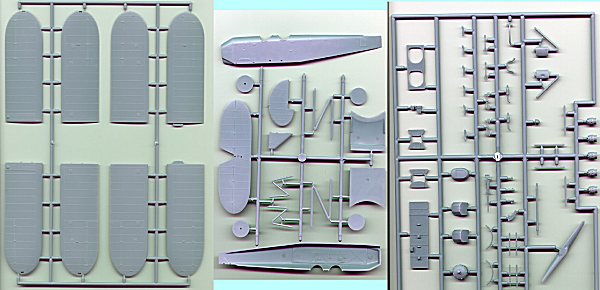
|
KIT: |
Gavia 1/48 Polikarpov Po-2 |
|
KIT # |
|
|
PRICE: |
$35 |
|
DECALS: |
Three versions |
|
REVIEW & |
|
|
NOTES: |
Injection molded styrene (50+ pieces), PE brass (20+ pieces on one sheet) and acetate (6 pices on one sheet) |

|
HISTORY |
The Po-2 was designed in 1927 by the legendary Nikolai Polikarpov as a trainer and
liaison aircraft. By the time production ceased in the late 50's, over 40,000 airframes had been built - making it one of the most produced aircraft (if not THE most produced aircraft) ever, by anyone. Well-liked for it's stability and responsiveness, it was used as
a trainer and liaison aircraft, as well as in night raider, light bomber and reconnaissance roles throughout WW2.
All but unknown in the West, there has never (to my knowledge) been a 1/48 scale kit of this plane.
|
THE KIT |
Gavia is another Czech kit maker elbowing it's way onto the world modeling scene. If this kit is any indication, it's headed straight for the top. I was reluctant to shell out $35 for something I knew nothing about .... but a few inquiries around the net, and a bit of wheeling and dealing at the shop, ended with me as the proud owner of one kit.
 I was not prepared for what I found in the box. The styrene parts come on three sprues of hard plastic. Unlike other limited run kits I have, the runners and sprue nubs
(attachments) are small and thin. Flash is non-existent. I can find no ejector pin markings in any places that will be obvious when the kit is built. The plastic is hard, but not brittle, with a very slightly rough surface that will probably be unnoticeable under a coat of paint. Others more qualified than I will have to be the judge of the fabric effect - it looks very well done to my eyes, with none of the troughs and peaks one usually sees.
I was not prepared for what I found in the box. The styrene parts come on three sprues of hard plastic. Unlike other limited run kits I have, the runners and sprue nubs
(attachments) are small and thin. Flash is non-existent. I can find no ejector pin markings in any places that will be obvious when the kit is built. The plastic is hard, but not brittle, with a very slightly rough surface that will probably be unnoticeable under a coat of paint. Others more qualified than I will have to be the judge of the fabric effect - it looks very well done to my eyes, with none of the troughs and peaks one usually sees.
There are no resin bits in this kit, but it looks like none are needed. The molding of the parts is top notch, with only a hint of mold seams on any of the bits in my box. The engine in particular looks sharp - the cylinders as crisp as if they were molded in resin from one of the better aftermarket companies. There are no alignment pins, as is
the norm for this type of kit. Dry fitting of the major assemblies, however, reveals few problems.
 The PE set includes numerous small details, such as control hinges, as well as the instrument panel. Instrument faces are provided on the acetate sheet, as are the two windscreens.
The PE set includes numerous small details, such as control hinges, as well as the instrument panel. Instrument faces are provided on the acetate sheet, as are the two windscreens.
Decals for three versions round out the package. Printed by Propagteam, the include markings for a Normandie-Nieman squadron hack, an anonymous Soviet Air Force machine, and a Czech flying club trainer (postwar). The decals are sharp and well -registered, though like all Propagteam decals, I'll probably coat these with liquid decal film so they'll be a bit easier to handle and position.
The 11 step, pictorial instructions are clearly drawn and look quite explicit. The paint guides for each version are equally clear. Colors are called out in generic terms ('Earthy Brown' or 'Dark Green'), and not keyed to any particular line of paints. The only thing missing is a rigging guide, though based on the photos I've found, the box art is an accurate enough guide.
|
CONCLUSIONS |
I'm glad I got this kit. The only trouble I can see is rigging the thing (there are a LOT of wires) .... but if I do it
straight OOB, I'll skip this step. If you're ready to move up to limited run kits, give this one a try (and if you can find it for less than thirty bucks, definitely do so!)
If you would like your product reviewed fairly and quickly by a site that has over 800 visits a day, please contact me or see other details in the Note to Contributors.